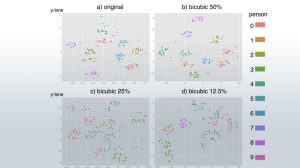Edge AI and Privacy
As sensors and AI proliferate in our devices and our environment, people are understandably concerned about the potential erosion of privacy. For example, there has recently been much discussion in the media about face recognition technology, and some governments have begun to regulate its use.
It may initially seem that the proliferation of sensors and AI must lead to loss of privacy. In reality, it’s possible to design intelligent, perceptive devices in ways that deliver valuable capabilities while protecting privacy. An early example of this is the Netatmo Welcome, a smart home monitoring camera that can be configured to disable video recording when familiar faces are present.
The purpose of this privacy portal is to facilitate awareness of the challenges and opportunities at the intersection of privacy, edge AI and machine perception.
View all Privacy Content

Protecting Privacy in a Data-Driven World: Privacy-Preserving Machine Learning
This blog post was originally published at Intel’s website. It is reprinted here with the permission of Intel. Privacy for machine learning (ML) and other data-intensive applications is increasingly threatened by sophisticated methods of re-identifying anonymized data. In addition, while encryption helps preserve privacy while data is stored on hard drives or moving over networks,

“Potential Impacts of Privacy Regulation and Litigation on Vision Technology,” a Presentation from Dorsey & Whitney LLP
Robert E. Cattanach, Partner at Dorsey & Whitney LLP, delivers the presentation “Potential Impacts of Privacy Regulation and Litigation on Vision Technology” at the Embedded Vision Alliance’s December 2019 Vision Industry and Technology Forum. Cattanach provides insights into the fast-changing world of privacy regulation and litigation.

Exploring Deep Learning Face Recognition with Thermal Images
This blog post was originally published at Intel's website. It is reprinted here with the permission of Intel. Interactions with computer systems frequently benefit from the ability to detect information about the user or use environment. Image processing and analyzing techniques, including deep neural networks (DNNs), are often used for this purpose. However, many promising
“Fundamental Security Challenges of Embedded Vision,” a Presentation from Synopsys
Mike Borza, Principal Security Technologist at Synopsys, presents the “Fundamental Security Challenges of Embedded Vision” tutorial at the May 2019 Embedded Vision Summit. As facial recognition, surveillance and smart vehicles become an accepted part of our daily lives, product and chip designers are coming to grips with the business need to secure the data that
“Designing Home Monitoring Cameras for Scale,” a Presentation from Ring
Ilya Brailovskiy, Principal Engineer, and Changsoo Jeong, Head of Algorithm, both of Ring, present the "Optimizing SSD Object Detection for Low-power Devices" tutorial at the May 2019 Embedded Vision Summit. In this talk, Brailovskiy and Jeong discuss how Ring designs smart home video cameras to make neighborhoods safer. In particular, they focus on three key
“Balancing Safety, Convenience and Privacy in the Era of Ubiquitous Cameras,” a Presentation from Intel
Charlotte Dryden, Director of the Visual Computing Developer Solutions team at Intel, presents the “Balancing Safety, Convenience and Privacy in the Era of Ubiquitous Cameras” tutorial at the May 2018 Embedded Vision Summit. Computer vision-enabled cameras are proliferating rapidly and will soon be ubiquitous – in, on and around vehicles, homes, toys, stores, public transit,

Computer Vision Solutions and Privacy-by-Design
This blog post was originally published at Intel’s website. It is reprinted here with the permission of Intel. These days cameras are ubiquitous – in our smart phones, our cars, homes, and around our cities. And opportunities for computer vision are endless, extending across robotics, retail, healthcare, transportation, and even sustainable agriculture. Computer vision offers

Privacy in the Era of Ubiquitous Cameras and AI
This blog post was originally published in the late July 2017 edition of BDTI’s InsideDSP newsletter. It is reprinted here with the permission of BDTI. Lately I’ve been thinking about the relationship between embedded vision and privacy. Surveillance cameras are nothing new, of course. For decades, they’ve been ubiquitous in and around restaurants, stores, banks,
“Should Visual Intelligence Reside in the Cloud or at the Edge? Trade-offs in Privacy, Security and Performance,” a Presentation from Silk Labs
Andreas Gal, CEO of Silk Labs, presents the "Should Visual Intelligence Reside in the Cloud or at the Edge? Trade-offs in Privacy, Security and Performance" tutorial at the May 2016 Embedded Vision Summit. The Internet of Things continues to expand and develop, including more intelligent connected devices that respond to people’s needs and alert them
“Using Vision to Create Smarter Consumer Devices with Improved Privacy,” a Presentation from Apical
Michael Tusch, Founder and CEO of Apical, presents the "Using Vision to Create Smarter Consumer Devices with Improved Privacy" tutorial at the May 2015 Embedded Vision Summit. Machines are valuable primarily due to their ability interact with people and with the physical world. But today, most of the consumer devices in the “Internet of Things”

